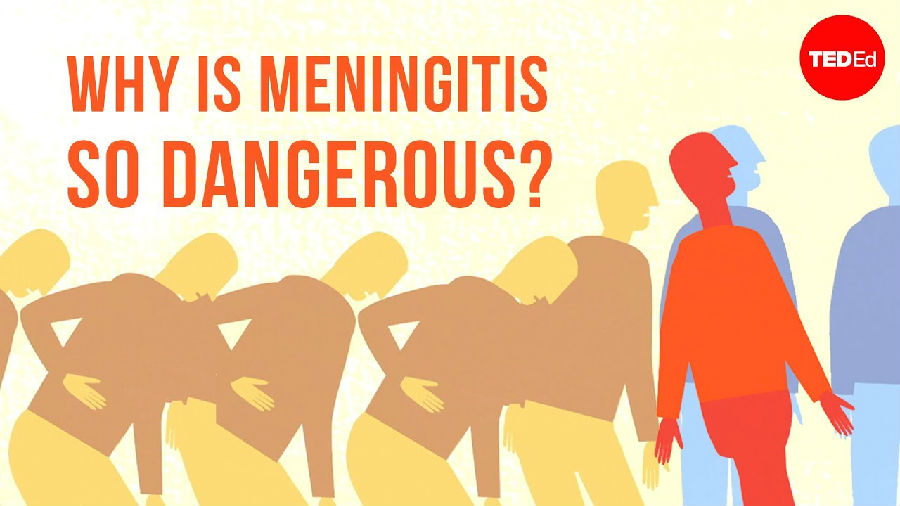In 1987, tens of thousands of people gathered in Saudi Arabia for the annual Hajj pilgrimage.
在1987年,数以万计的人聚集在沙特阿拉伯,参加一年一度的麦加朝圣。
But what started out as a celebration led to a health crisis:
但本是一场宗教仪式的朝圣,却导致了一场健康危机:
just a few days after the pilgrimage, more than 2,000 cases of meningitis broke out spreading across Saudi Arabia and the rest of the world.
仅在朝圣后的几天,就有超过2000起脑膜炎病例爆发,并扩散到整个沙特阿拉伯和世界其他地区。
The outbreak was so fierce that it was believed to have sparked a wave of deadly meningitis epidemics
这场爆发势头强劲,以至于引发了一轮致死性脑膜炎的大流行,
that ultimately infected tens of thousands of people worldwide.
最终使得全球数以万计的人被感染。
Meningitis is the inflammation of the meninges, three tissue layers responsible for protecting the brain and spinal cord.
脑膜炎是脑膜的炎症,脑膜是保护脑和脊髓的三层组织。
What makes meningitis so dangerous compared to other diseases is the sheer speed with which it invades a person's body.
脑膜炎比起其他疾病十分致命,是因为它以极快的速度入侵人体。
In the worst cases, it causes death within a day.
在极端的案例中,脑膜炎可在一天内致死。
Fortunately, that's rare for patients who receive early medical treatment.
幸运的是,这种情况在及时接受治疗的患者中很少见。
The disease primarily comes in three forms: fungal, viral, and bacterial -- the last being the most deadly by far, and what we'll focus on.
脑膜炎主要有三种形式:真菌,病毒和细菌,细菌性脑膜炎是三者中最危险的,我们会解释此类脑膜炎的机理。
People usually contract bacterial meningitis by breathing in tiny particles of mucus and saliva that spray into the air when an infected person sneezes or coughs.
当脑膜炎患者咳嗽或打喷嚏时,空气中的黏液和唾液微粒可能会被吸入以导致细菌性脑膜炎的传播。
It can also be transmitted through kissing, or sharing cigarettes, toothbrushes or utensils.
此类脑膜炎也可以通过接吻、共享香烟、牙刷或餐具传播。
Some people can be infected and carry the disease without showing symptoms or getting sick, which helps the disease spread quickly to others.
有些患者可能不会显现出明显的症状,使得脑膜炎在人群中快速传播。
Once the bacteria enter the nose, mouth, and throat, they cross the surrounding membranes and enter the bloodstream.
一旦细菌进入鼻腔、口腔和咽喉,就会跨越周围的黏膜并进入血液循环。
From there, bacteria have rapid access to the body's tissues -- including a membrane called the blood-brain barrier.
在血液中,细菌可以快速侵入人体组织,这些组织包括了血脑屏障。
This is made of a tight mesh of cells which separate blood vessels from the brain,
一种隔开血管和脑的,由细胞紧密排列组成的膜,
and block everything except for a specific set of particles, including water molecules and some gases.
血脑屏障只允许特定的微粒通过,包括水分子和一些气体。
But in ways that scientists are still trying to understand, meningitis bacteria can trick the barrier into letting them through.
但让科学家困惑的是,导致脑膜炎的细菌会“欺骗”血脑屏障来允许它通过。

Inside the brain, the bacteria swiftly infect the meninges.
在脑中,细菌会快速感染脑膜。
This triggers inflammation as the body's immune response kicks into overdrive, bringing on fever and intense headaches.
这会使得人体发生激烈的免疫反应,引起炎症,并导致发热和强烈的头痛。
As swelling in the meninges worsens, the neck begins to stiffen.
脑膜的肿胀加剧会使得患者的颈部僵硬。
Swelling in the brain disrupts its normal function -- causing symptoms like hearing loss and extreme light sensitivity.
此外,它还会阻碍脑的正常功能,导致失聪或畏光等症状。
As pressure increases in the cranium, it may also make the person confused -- one of the hallmarks of the disease.
颅内压力的增加会导致神志模糊,这是脑膜炎的典型症状之一。
A few hours in, the rapidly multiplying bacteria start to release toxins, leading to septicemia, also known as blood poisoning.
在数个小时中,快速繁殖的细菌会开始释放毒素,导致败血病。
This breaks down blood vessels,
败血病会破坏血管,
letting blood seep out and form what starts out looking like a rash, and evolves into big discoloured blots beneath the skin.
从血管中渗出的血液会形成形如皮疹的淤血并不断扩大。
At the same time, these toxins burn through oxygen in the blood, reducing the amount that gets to major organs like the lungs and kidneys.
同时,细菌中的毒素会大量消耗血液中的氧气,减少肺和肾等重要器官的供氧。
That increases the chance of organ shut down -- and alongside spreading septicemia, threatens death.
这会增加器官衰竭的几率,并使败血病扩散,有致死风险。
That all sounds scary, but doctors are so good at treating meningitis
这听起来很吓人,但现代医学可以有效治疗脑膜炎,
that a visit to the hospital can drastically reduce an adult's risk of dying from it.
及时治疗可以显著减少脑膜炎的致死几率。
The longer it's left untreated, though, the more likely it will lead to lasting damage.
然而,若是不及时接受治疗,脑膜炎就可能造成长期的损害。
If declining oxygen levels cause cell death in extreme parts of the body
若是细胞缺氧导致肢体末端的细胞死亡,
like fingers, toes, arms and legs -- the risk of amputation goes up.
如手指、脚趾和上下肢,截肢风险就会上升。
And if bacterial toxins accumulate in the brain and trigger cell death, meningitis could also cause long-term brain damage and memory loss.
若细菌毒素在脑中积累并引发细胞死亡,脑膜炎就会造成长期的脑损伤和失忆。
So fast treatment, or better yet, prevention, is critical.
所以及时的治疗或是预防十分重要。
That's why most countries have vaccines that defend against the disease in its deadliest forms.
因此绝大多数国家都有针对细菌性脑膜炎的育苗储备。
Those are usually given to the people who are most at risk -- like young children, people with weak immune systems,
此类疫苗通常被分配给易感染脑膜炎的群体,如幼儿,免疫系统虚弱者
or people who gather in large groups where an outbreak of meningitis could potentially happen.
和经常处于大量人群中的人,在这些群体中,脑膜炎更容易爆发。
In addition to those gatherings, meningitis is most common in a region called the meningitis belt that stretches across Africa,
除了人群聚集处,脑膜炎最多发于被称作“脑膜炎带”的地区,这个地区横跨非洲。
though cases do happen all over the world.
当然,全球的其他地区也出现过脑膜炎的病例。
If you're concerned that you or someone you know may have meningitis, get to the doctor as soon as possible; quick action could save your life.
若你担心你或你认识的人患有脑膜炎,请尽快就医,及时的治疗可能拯救生命。


